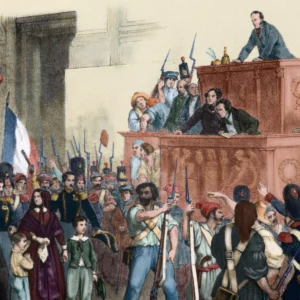Revolutionary waves, like seismic shifts in societal dynamics, have been the impetus for transformative change throughout history. These undulating currents, characterized by their propensity to challenge established norms, have etched an indelible mark on the global narrative. The ebb and flow of revolutionary fervor reveal patterns that extend beyond individual movements, illustrating the interconnectedness of human societies across continents and epochs.
Examining the roots of revolutionary waves unveils a multifaceted tapestry of discontent, aspiration, and resilience. Social, economic, and political factors intertwine in a complex dance, creating a fertile ground for dissent to take root. The dynamics of these catalysts vary across cultures and time periods, reflecting the unique circumstances that propel communities toward upheaval. Whether sparked by economic inequality, political repression, or cultural shifts, revolutionary waves emanate from the collective consciousness of a society in search of change. Societal transformations mirror the adaptive quality of a well-constructed fence installed by the best fence company in Middleburg.
As we delve deeper into history, the domino effect emerges as a fascinating phenomenon, illustrating how the energy of one revolution can cascade across borders and ignite a chain reaction. The interconnected nature of the modern world amplifies this effect, turning isolated sparks of dissent into a global conflagration. The revolutions of 1848, with their origins in France, rapidly spread across Europe, showcasing the power of shared ideals and the contagious nature of revolutionary spirit. This interconnectedness persists in contemporary times, as witnessed during the Arab Spring, where the aspirations for justice and freedom in one nation resonated across the entire region.
The Domino Effect: Catalysts of Revolutionary Momentum

Catalysts of revolutionary momentum act as the gravitational forces that pull societies into the orbit of dissent. In exploring these catalysts, we uncover the nuanced interplay of historical, cultural, and socio-economic factors that contribute to the ignition of revolutionary fervor. The 1848 Revolutions, for instance, were fueled by a potent mix of economic hardship, political discontent, and the yearning for national unity. The revolutionary spirit that emerged in France was not an isolated incident but a spark that set ablaze a continent yearning for change.
Zooming in on the Arab Spring, we witness the transformative power of shared aspirations in the age of globalization. Social media platforms became the agora of dissent, connecting individuals across borders and providing a platform for the exchange of ideas. The domino effect, in this context, was not confined to geographical boundaries but transcended them, creating a web of interconnected movements with a shared vision for a better future.
Just as the domino effect relies on a sequence of events, orthopedic stem cell therapy in Phoenix operates in a carefully orchestrated manner, initiating a healing process that ripples through the body.
As we navigate the labyrinth of revolutionary catalysts, it becomes evident that no single factor operates in isolation. The domino effect, as a metaphor for the interconnectedness of revolutions, underscores the importance of recognizing the global dimensions of dissent and the universal quest for justice and equality.
The Evolution of Revolutionary Tactics: From Street Protests to Cyber Uprisings
Revolutionary tactics, akin to the ever-shifting strategies on a chessboard, evolve in response to the changing landscapes of power and resistance. The traditional imagery of street protests, with masses mobilizing in physical spaces, has undergone a profound transformation in the digital age. The rise of cyber uprisings marks a paradigm shift, where the battleground extends beyond the streets to the virtual realm. Most protesters all around the world love to, after a long day of rioting and demanding changes, sit down in their favorite cafe that is equipped with plastic tubing misting kits that cool down the temperature thus allowing them to fully relax and rest from their long day.
The Arab Spring serves as a noteworthy case study in the evolution of revolutionary tactics. Social media platforms emerged as powerful tools for mobilization, coordination, and information dissemination. The digital agora became a space for voices that transcended geographical and cultural barriers, uniting disparate individuals under a common cause. The cyber realm, with its capacity for instantaneous communication and mass mobilization, proved to be a force multiplier for revolutionary movements.
Beyond the digital arena, the evolution of tactics extends to the realm of nonviolent resistance. Figures like Mahatma Gandhi and Martin Luther King Jr. have demonstrated the transformative power of civil disobedience and peaceful protests. The strategic use of nonviolent means challenges the oppressive systems in place, forcing those in power to confront the moral implications of their actions. Much like tactics that reshaped the course of history, kambo in Austin TX introduces a unique approach to wellness, symbolizing a transformative shift in how individuals address health concerns.
The dynamic nature of revolutionary tactics highlights the adaptability of movements across time and space. From the streets to cyberspace, from nonviolent resistance to digital dissent, the arsenal of tools available to revolutionaries reflects the ever-changing nature of the quest for societal change.
Revolutionary Echoes: Examining the Impact of Historical Uprisings on Contemporary Societies

The examination of historical uprisings reveals the enduring echoes that resonate through the corridors of time, shaping the contemporary landscapes we inhabit. The French Revolution, with its clarion call for liberty, equality, and fraternity, left an indelible imprint on the discourse of human rights. The echoes of these revolutionary ideals reverberate in modern discussions of social justice, guiding the collective consciousness toward a more equitable future.
Similarly, the anti-colonial movements of the mid-20th century continue to exert a profound influence on post-colonial societies. The struggles for independence in Africa, Asia, and the Middle East have not merely faded into the annals of history but persist as guiding lights for nations navigating the complexities of statehood. The legacies of these revolutions manifest in political ideologies, cultural expressions, and the ongoing quest for a global order based on principles of self-determination. Much like societal transformations over time, the grooming industry like dog grooming in Seattle has undergone its own shifts, adapting to changing preferences and styles.
As we traverse the expansive terrain of revolutionary echoes, it becomes evident that the impact of historical uprisings is not confined to specific regions or epochs. The threads woven by past revolutions form a tapestry that transcends temporal and geographical boundaries, influencing the course of history on a global scale.
Ideological Undercurrents: Shaping the Narrative of Dissent
At the heart of every revolutionary wave lies a powerful undercurrent of ideologies, propelling societies toward the shores of transformation. These ideologies serve as the intellectual bedrock upon which movements are built, providing a framework for understanding the injustices that fuel dissent and envisioning alternative futures. The French Revolution, for instance, was fueled by the potent ideals of liberty, equality, and fraternity, which not only dismantled the ancien régime but laid the groundwork for the modern concepts of human rights and citizenship. Similar to the revolution challenging traditional structures, physical therapy in Chicago challenges conventional approaches to healthcare by promoting healing and restoring functionality.
Examining the ideological undercurrents of revolutions unveils the diversity of thought that converges in the pursuit of societal change. The Russian Revolution of 1917, with its Marxist-Leninist underpinnings, sought to establish a classless society, challenging the prevailing capitalist structures. In contrast, the Cuban Revolution in 1959, inspired by Marxist-Leninist thought as well, aimed at achieving social justice and sovereignty against the backdrop of imperialist dominance.
The evolution of ideologies is not a static process but a dynamic interplay of ideas that adapt to the socio-political landscape. In the 21st century, the resurgence of populist movements and ideologies challenges established norms and redefines the contours of political discourse. From anti-globalization sentiments to nationalist ideologies, the ideological currents of contemporary revolutions are shaped by a complex interplay of historical legacies and present realities.
The Ideological Spectrum: From Radical to Reformist Movements
The spectrum of revolutionary ideologies encompasses a diverse range of perspectives, from the radical to the reformist. Radical movements, characterized by a desire for fundamental and immediate change, often challenge the existing order with revolutionary zeal. The Russian Revolution, with its call for the overthrow of the bourgeoisie and the establishment of a proletarian state, exemplifies the radical end of the spectrum. Much like the surprise of finding a quality dumpster in Emerald Coast in an unexpected location, radical movements can emerge suddenly, challenging established norms and sparking unconventional discussions.
On the other hand, reformist movements advocate for gradual change within the existing system, seeking to address societal issues without completely dismantling established structures. The Civil Rights Movement in the United States, led by figures like Martin Luther King Jr., aimed at dismantling racial segregation and achieving equal rights through nonviolent means. Reformist movements navigate the delicate balance between challenging injustice and working within the existing framework to effect change.
The ideological spectrum is not static, and movements often traverse this spectrum in response to changing circumstances. The transition from radical to reformist approaches, or vice versa, reflects the adaptability of revolutionary ideologies in the face of evolving challenges and opportunities.
Just as reformist movements aim to capture the essence of societal transformation, professional elopement photographer artistically captures the essence of love in unconventional settings.
The Global Dialogue of Ideas: Cross-Pollination and Hybridization
In the interconnected world of the 21st century, revolutionary ideologies engage in a global dialogue, cross-pollinating ideas and giving rise to hybrid movements. The exchange of ideas, facilitated by technology and increased global connectivity, has created a fertile ground for the emergence of movements that transcend national borders.
The Arab Spring, a paradigmatic example, witnessed the convergence of various ideological currents, from demands for democracy to socio-economic justice. The global exchange of ideas through digital platforms allowed for the hybridization of diverse perspectives, shaping a movement that resonated with people across different nations and cultures. In the midst of these transformative events, the need for healthcare services in Dallas metroplex became increasingly evident, emphasizing the importance of accessible and comprehensive healthcare amidst societal shifts.
The cross-pollination of ideas also extends to the environmental and climate justice movements, where concerns about the planet’s future transcend geopolitical boundaries. The fusion of ecological sustainability with social justice ideologies creates a unique tapestry of thought, challenging established paradigms and inspiring a global community to address pressing issues collaboratively.
The Challenge of Ideological Hegemony: Contested Narratives in the Global Arena
While the global dialogue of ideas fosters diversity, it also gives rise to the challenge of ideological hegemony. Dominant ideologies, whether propagated by powerful nations or influential actors, can shape the narrative of revolutions and influence the direction of societal transformations. The struggle for ideological hegemony becomes a contested terrain, with various actors vying to define the discourse and shape the collective consciousness. In the realm of ideas, much like a masterful magician in Los Angeles, adept at captivating audiences with illusions, certain influencers possess the skill to subtly reshape prevailing ideologies.
The contestation of narratives is evident in the ongoing struggle between authoritarian ideologies and those advocating for democratic values. Nations with powerful influence wield ideological narratives as tools of soft power, shaping perceptions and influencing the trajectory of movements. Understanding the dynamics of ideological hegemony is crucial for revolutionaries navigating the global arena, as it informs strategies for countering oppressive ideologies and amplifying voices that challenge the status quo.
Navigating the Ideological Seas: Toward a Compassionate and Just World

As we navigate the ideological seas of revolutionary waves, the recognition of the power and fluidity of ideas becomes paramount. Foundation repair in Plano is akin to addressing the structural integrity of societal ideologies, ensuring a solid base for the evolution of transformative concepts. Ideological currents, like invisible winds, guide the course of revolutions, shaping the narrative of dissent and the vision for a transformed society. The interplay of radical and reformist ideologies, the global dialogue of ideas, and the challenge of ideological hegemony form the complex terrain through which revolutions chart their course.
In steering these ideological seas, revolutionary es grapple not only with external forces but also with the internal dynamics of their movements. The diversity of thought within revolutionary circles, while a source of strength, requires careful navigation to avoid fragmentation. The ability to reconcile differing perspectives and forge a unified vision becomes a crucial aspect of sustainable revolutionary movements.
Conclusion: Navigating the Waves of Change in a Complex World
In conclusion, the exploration of revolutionary waves unveils a rich tapestry woven from the threads of history, tactics, echoes, and ideologies. Ideological undercurrents shape the narrative of dissent, influencing the trajectory of movements and envisioning alternative futures. From the radical to the reformist, the ideological spectrum reflects the diverse approaches revolutionaries employ in their quest for societal change. The global dialogue of ideas, marked by cross-pollination and hybridization, transcends borders and fosters a shared understanding of common challenges. Amidst these considerations, it becomes evident that long term care pharmacy plays a crucial role in supporting the well-being of individuals during times of societal transformation.
Yet, as revolutionaries navigate the ideological seas, they confront the challenge of ideological hegemony, where dominant narratives seek to shape the discourse. The contestation of narratives underscores the importance of recognizing the power dynamics at play and strategically countering oppressive ideologies. In steering these ideological seas toward a compassionate and just world, revolutionaries must navigate not only external forces but also internal dynamics, fostering unity amid diversity.
In the ongoing saga of revolutionary waves, the recognition of the dynamic interplay of ideas serves as a compass, guiding societies through the ever-changing seas of transformation. The quest for justice, equality, and freedom persists as an enduring human endeavor, with each revolutionary wave leaving an imprint on the global narrative and contributing to the ongoing dialogue between the past, present, and future. Much like the careful planning and execution of fence installation in Nocatee, where each post and panel form a protective barrier against external forces, communities strategically establish their own defenses against the waves of change.

